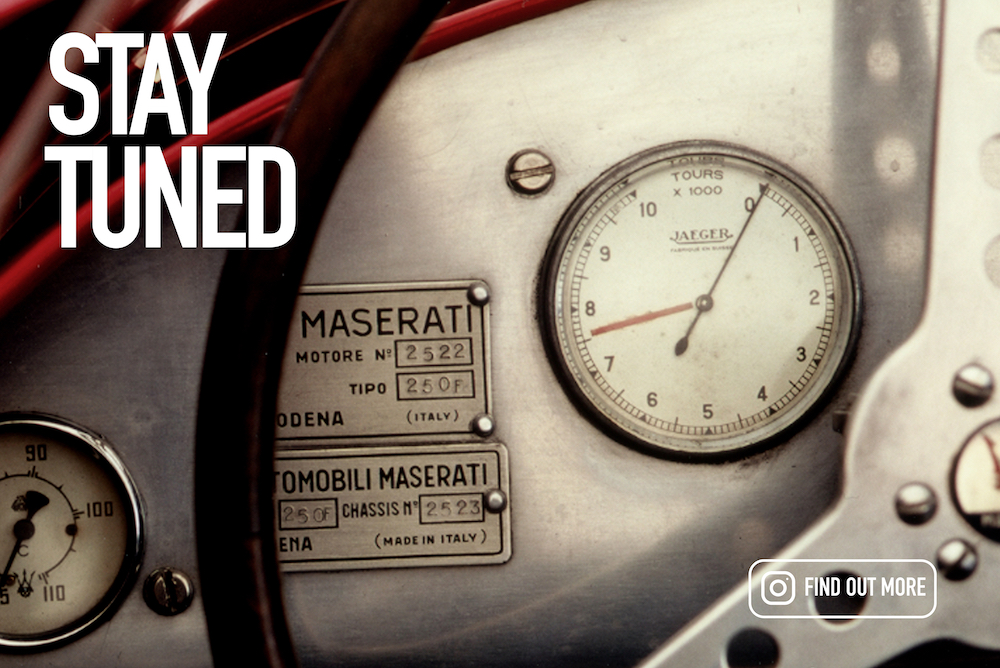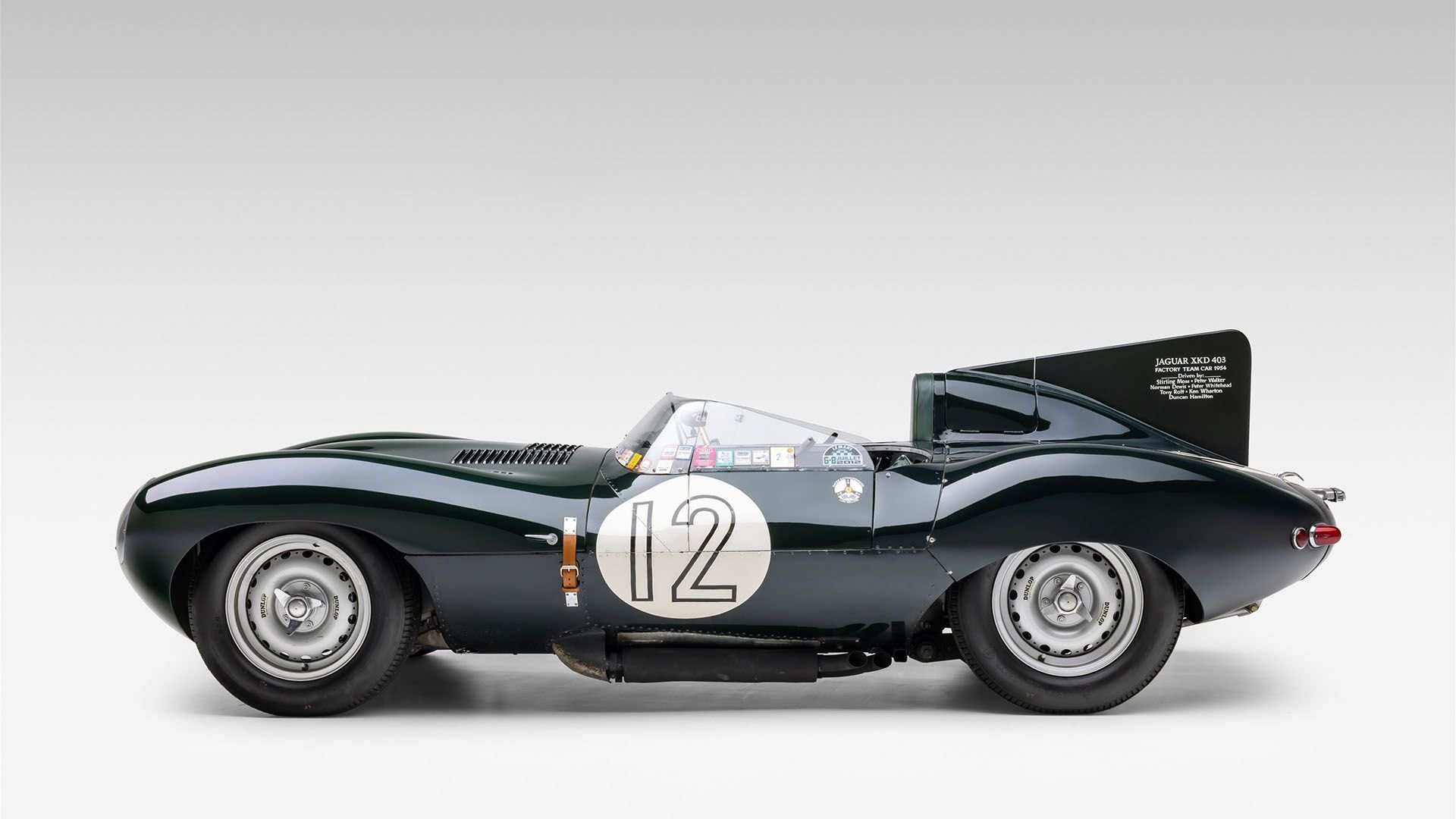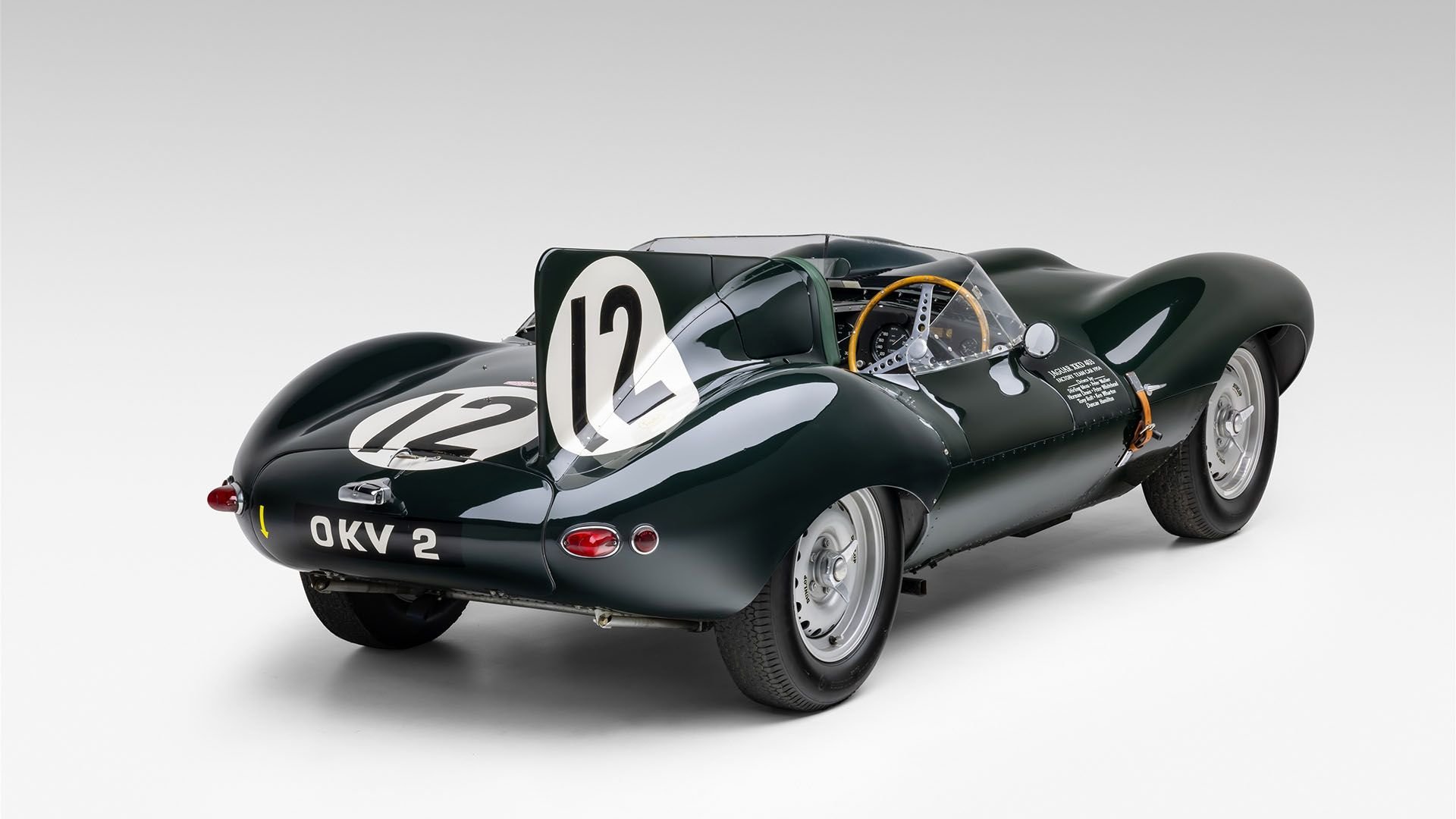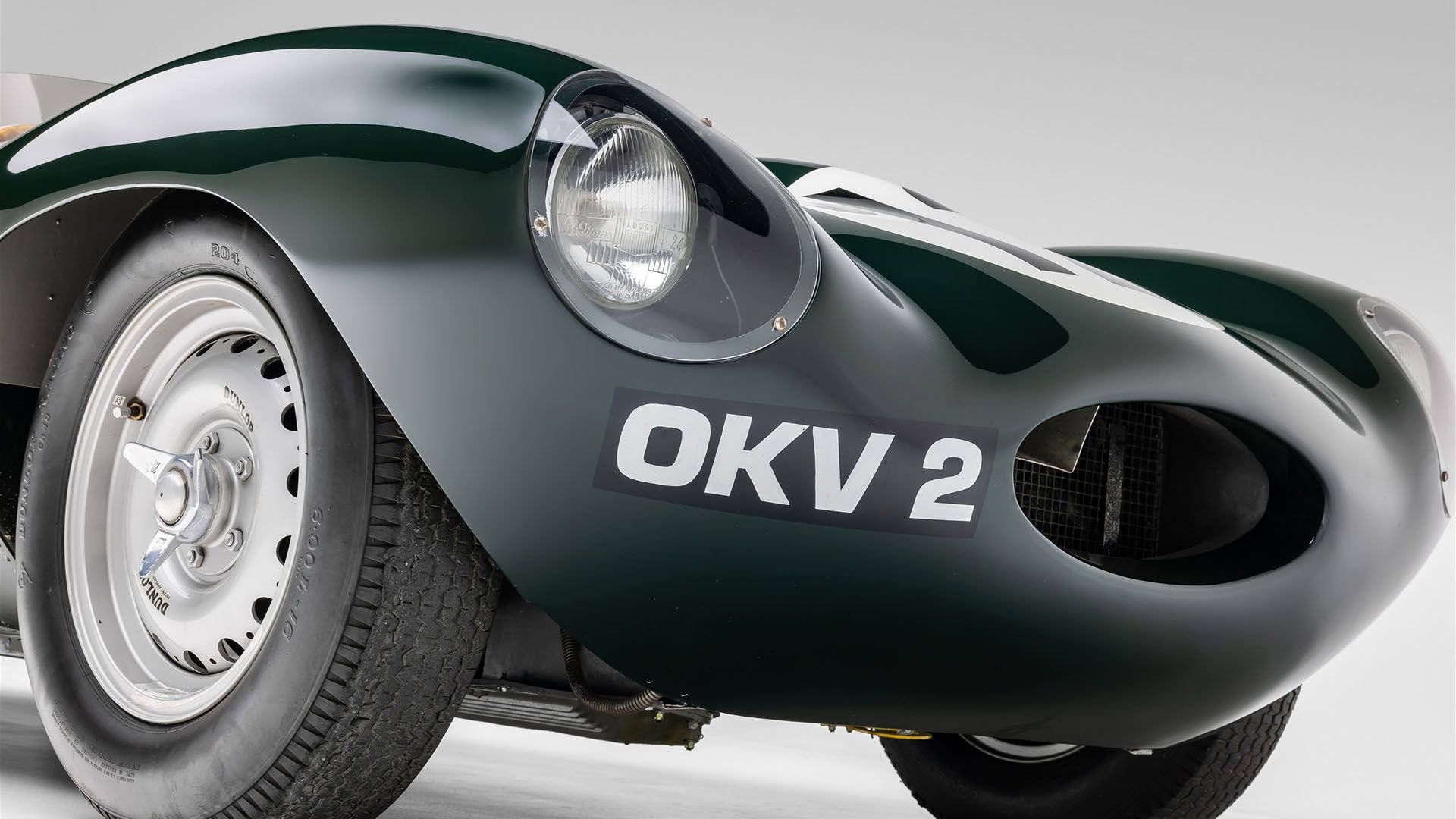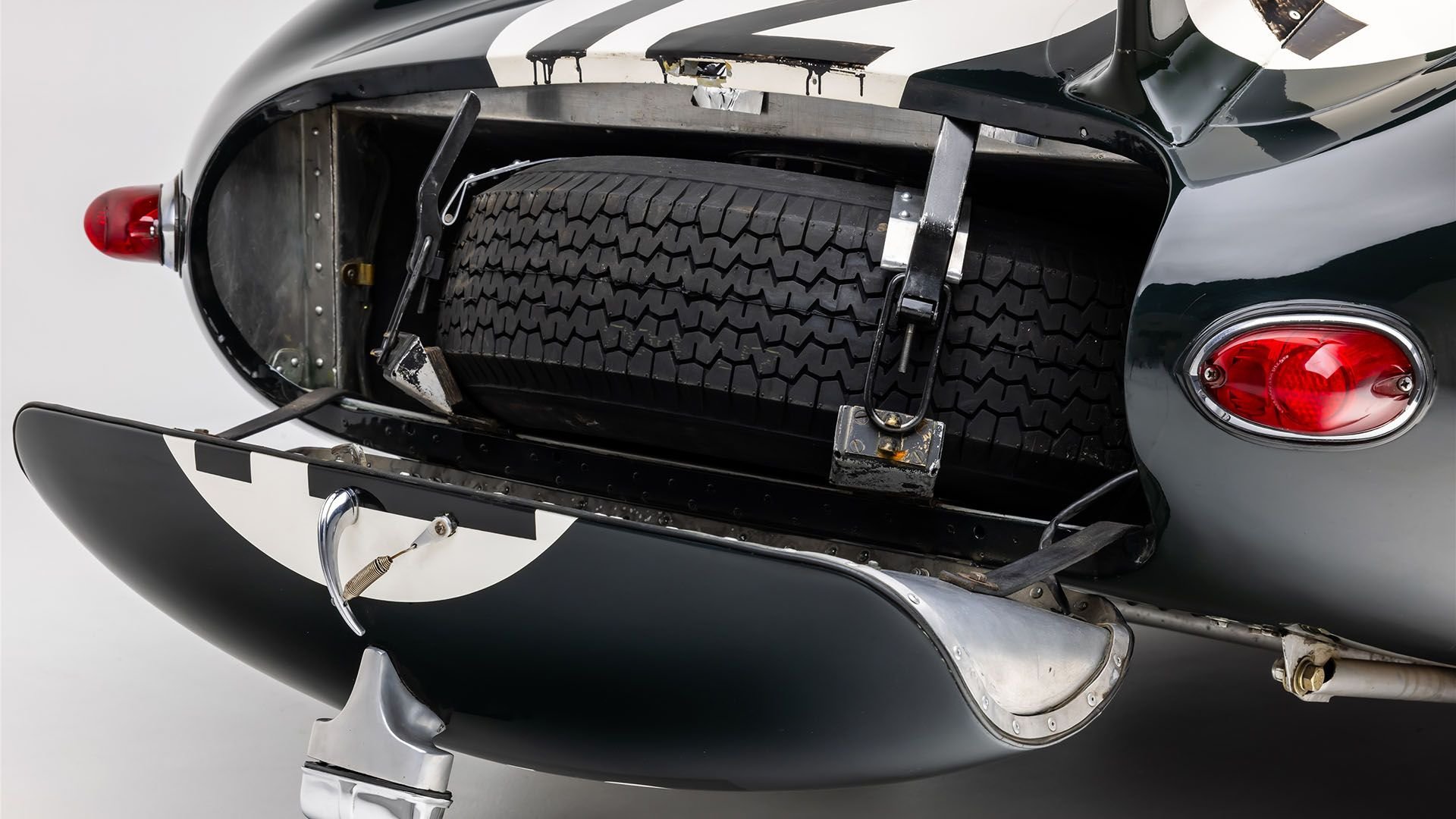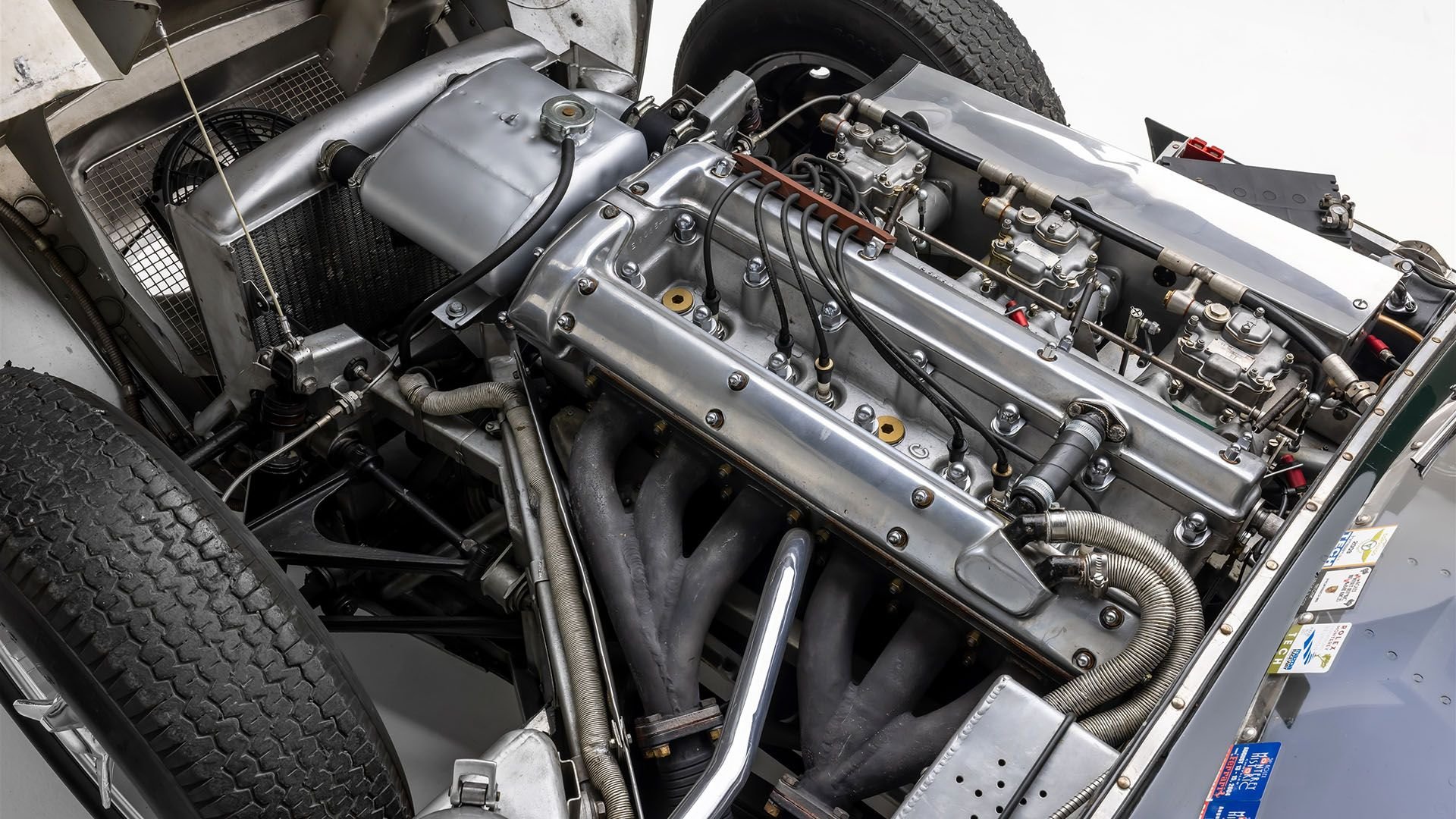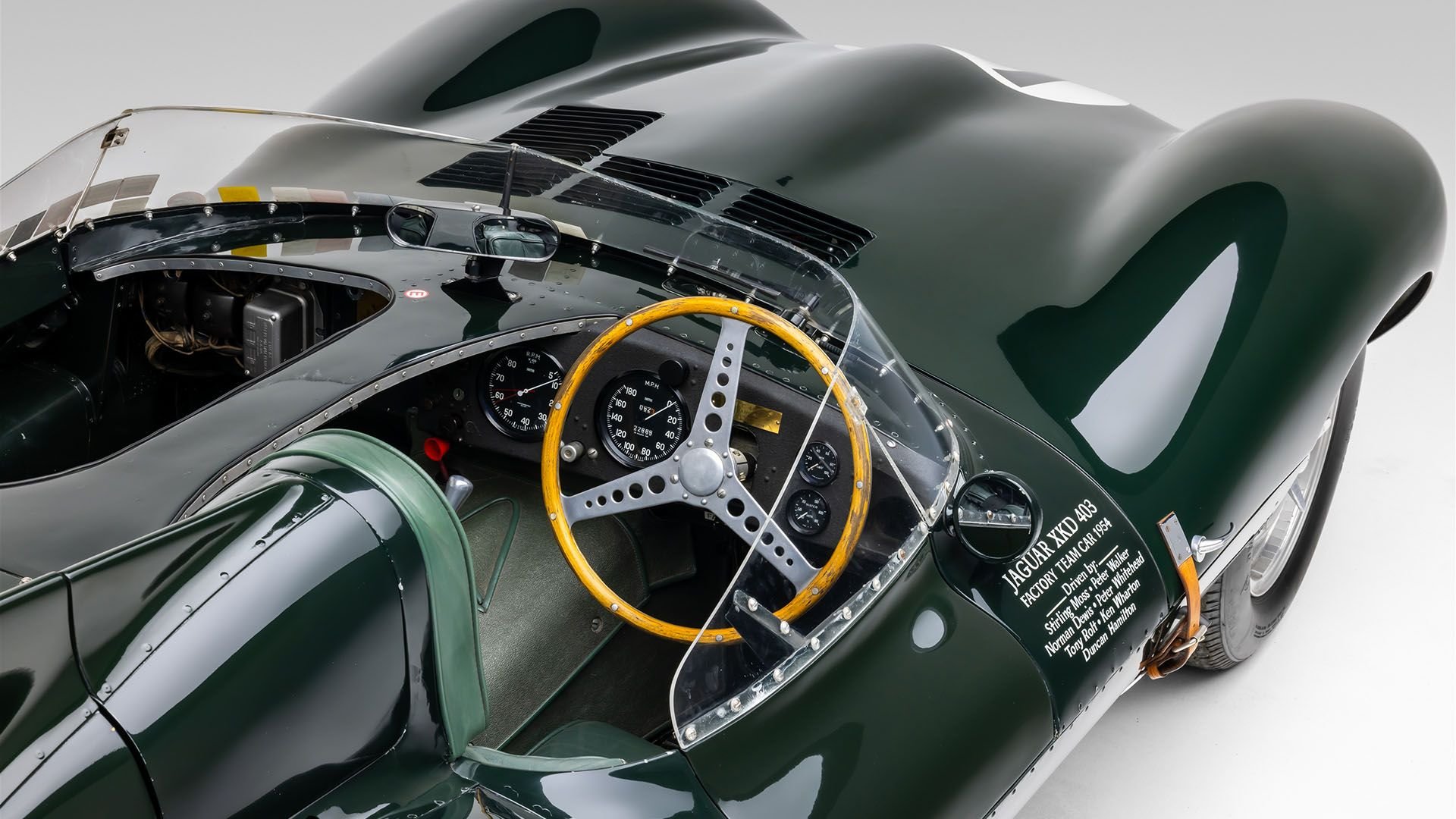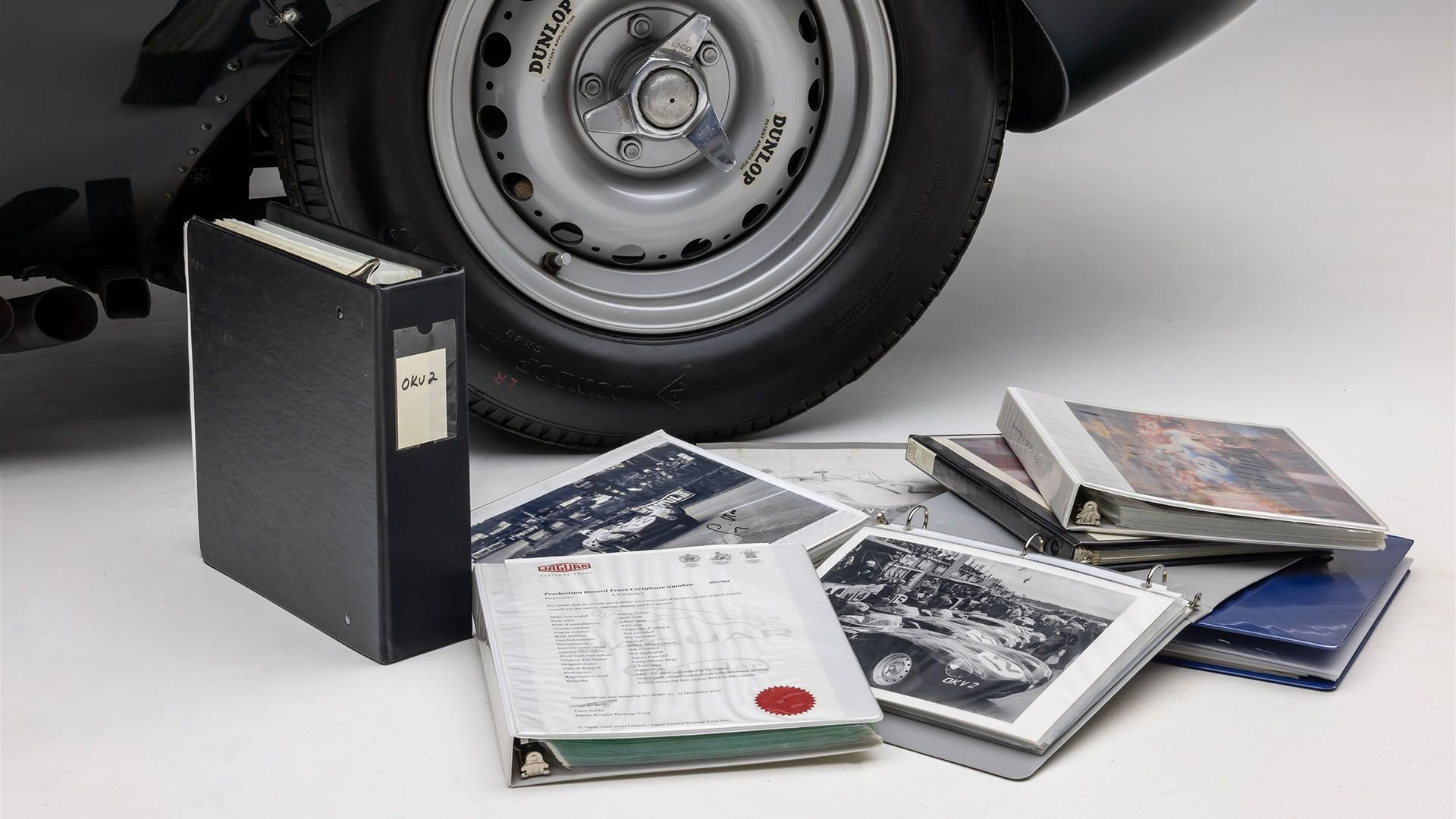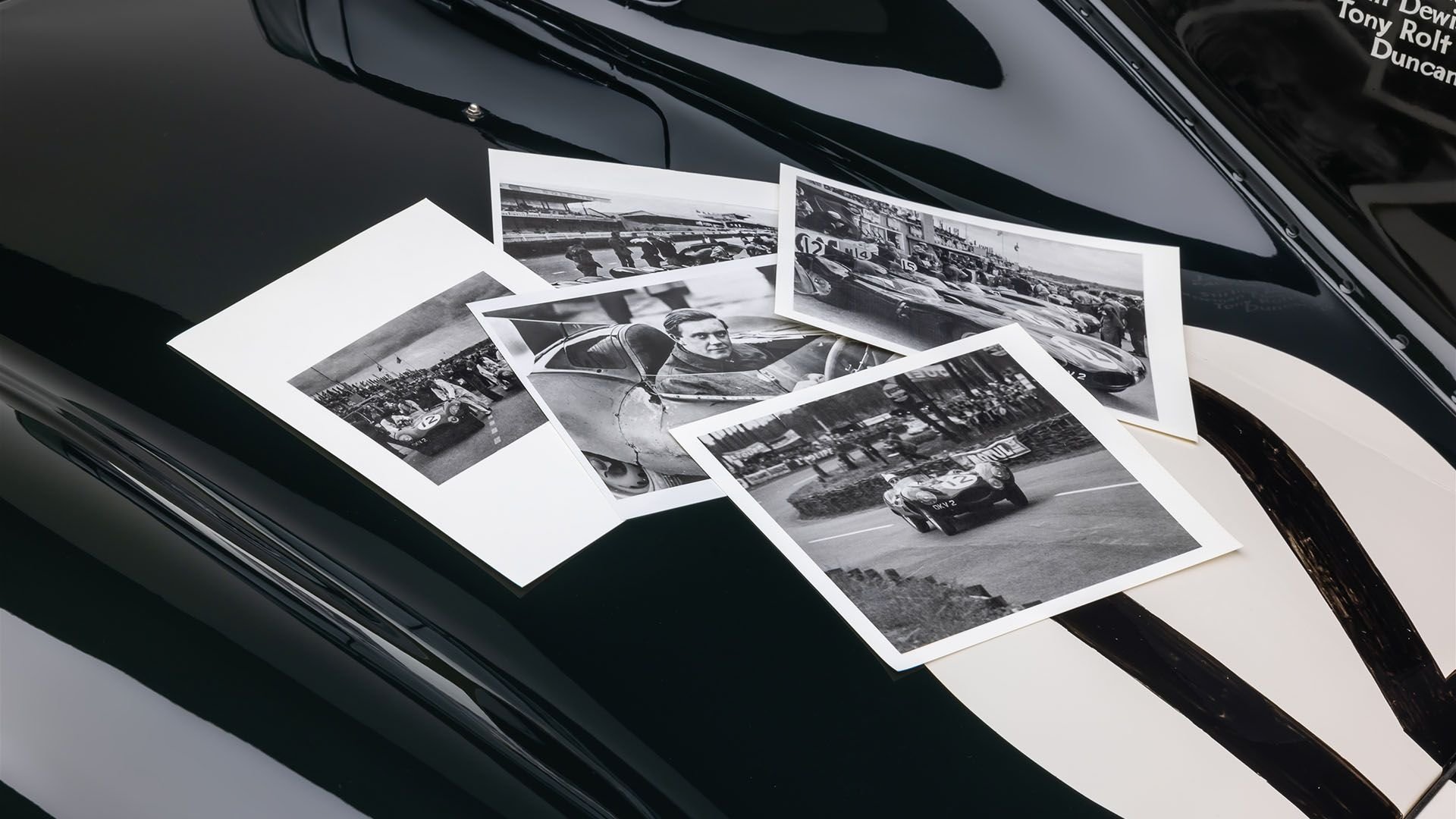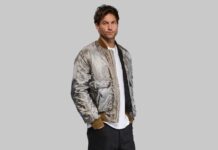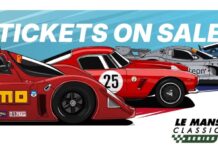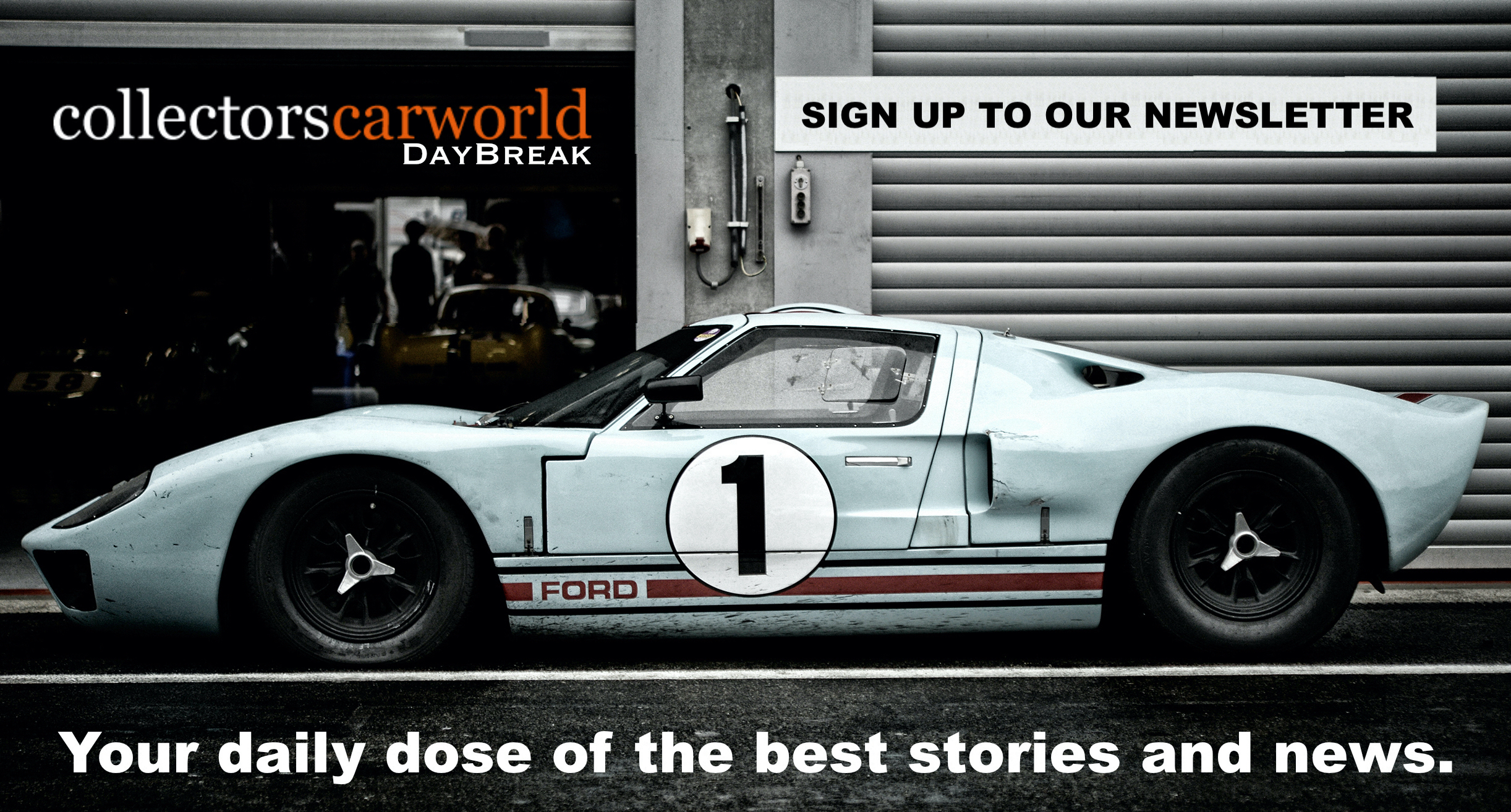Jaguar’s C-Type, built expressly for demands of the 24 Hours of Le Mans, marked the start of Jaguar’s dominance at Circuit de la Sarthe in the 1950s, winning in 1951 and 1953. Its lightweight spaceframe, powerful and reliable 3.4-liter XK engine, and pioneering Dunlop disc brakes marked Jaguar as a race-winning innovator, but it was the D-Type, designed by Bill Heynes and Malcolm Sayer, that revolutionized sports car design—even if their competitors didn’t know it at the time. Inspired by aircraft engineering, the D-Type combined a monocoque central “tub” for rigidity with square tube subframes, creating an exceptionally strong, lightweight structure.
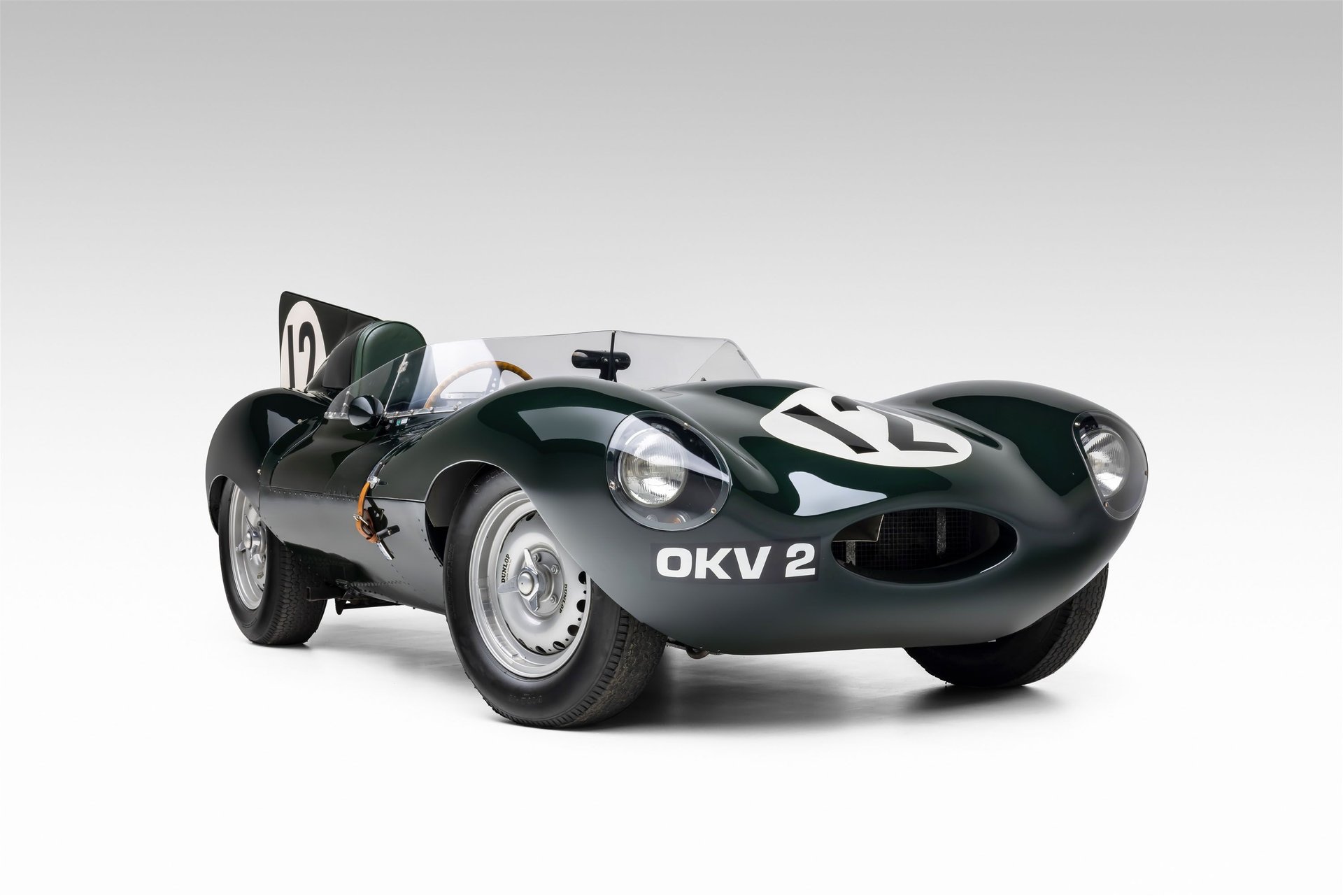
It didn’t hurt that the D-Type was achingly gorgeous with its aerodynamics contoured for new top speed records that Jaguar seemed to set year after year. This advanced design gave the D-Type a cutting-edge advantage, helping it achieve a hat trick of Le Mans victories.
XKC 403 – OKV 2
The earliest D-Types were constructed for use solely by the Works competition department, prefixed XKC, as the designation “D” had not yet been decided upon. As part of this group of special cars, this Jaguar D-Type, first designated as XKC 403, was constructed in the first group of three that included 402 and 404 for Jaguar’s all-out assault on the 1954 24 Hours of Le Mans. The first D-Type chassis, XKC 401, was brought as a backup for the 24-hour event—already considered the world’s most important endurance race. In fact, Jaguar was so focused on the success of the D-Type at Le Mans that they never pursued maximizing points with the design at other sports car races. All three D-Types were fitted with the iconic aerodynamic “tail fin.” Victory at Le Mans meant everything to Coventry.
On account of their two previous overall victories in 1951 and 1953, the Jaguar Works team had their pick of the finest international driving talent, yet the fiercely national enterprise (they had even notified the secretary of HRM Queen Elizabeth II of their 1953 Le Mans victory) only selected those from the British Isles. Duncan Hamilton and Tony Rolt would pilot 402 as start number 14, Peter Whitehead and Ken Wharton would pair in 404 as start number 15. Chassis 403, registered with number plate OKV 2, the car on offer here, was designated as “team lead” and started Stirling Moss and his favored co-driver Peter Walker, paired together after their successful second place at Le Mans behind the wheel of a C-Type in 1953. The team lead designation was well deserved. Moss and Walker set the fastest time in practice and a record top speed of a blistering 172.97 miles per hour with OKV 2 down the Mulsanne straight. As expected, the Moss/Walker D-Type led the early stages of the race against the larger-engined Ferrari 375s and Cunningham C-4Rs. By midnight, while leading the race, OKV 2 would retire with brake issues, perhaps their unbelievable speed into Virage de Mulsanne too much for even Dunlop’s cutting-edge disc brakes. Likely little consolation to Moss and Walker was the second place finish by the 1953 winners Hamilton and Rolt, just one lap down to the winning Ferrari 375 Plus.
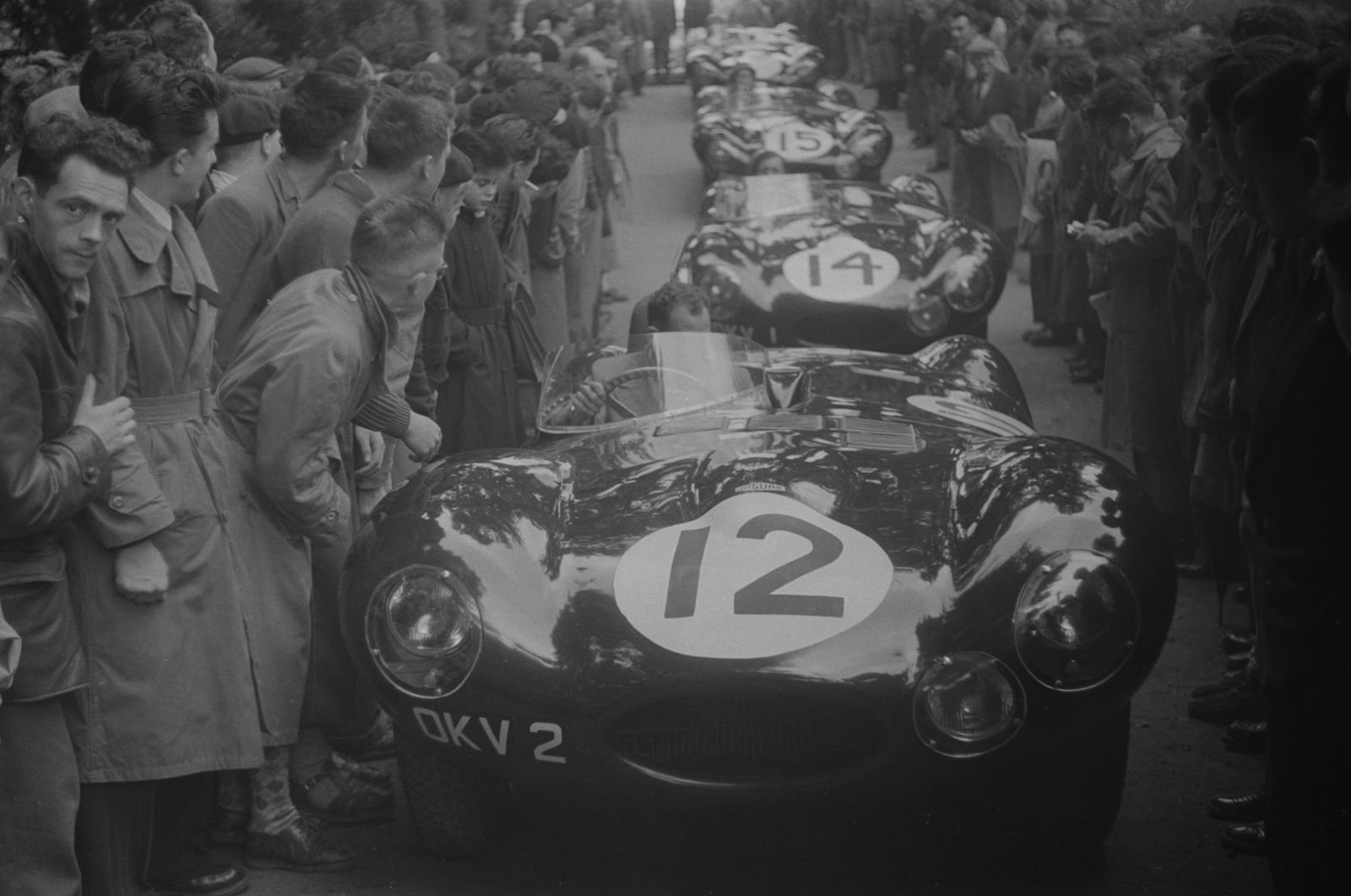
Following Le Mans, Moss and Walker would again pair in OKV 2 at the 41st 12 Hours of Reims. Designated the lead car once again with start number 1, the D-Type would suffer another technical malady, this time an issue with a halfshaft. September brought a 5th place finish by Peter Whitehead and Ken Wharton at the RAC Tourist Trophy run on the roads around Dundrod in Northern Ireland. That fall, the car was retained by the Jaguar Works competition department for testing by legendary Jaguar racer and test driver Norman Dewis. OKV 2 would be entered by the Jaguar Works for its first race of 1955, the Daily Express International Trophy at Silverstone where Tony Rolt would get his turn with chassis 403 as start number 2, finishing first in class and third overall. In advance of Le Mans, Team Manager “Lofty” England sequestered OKV 2 and a crop of drivers that included Mike Hawthorne and Ninian Sanderson to Silverstone for a test session to see who would race for the Works team in the 24-hour race that year.
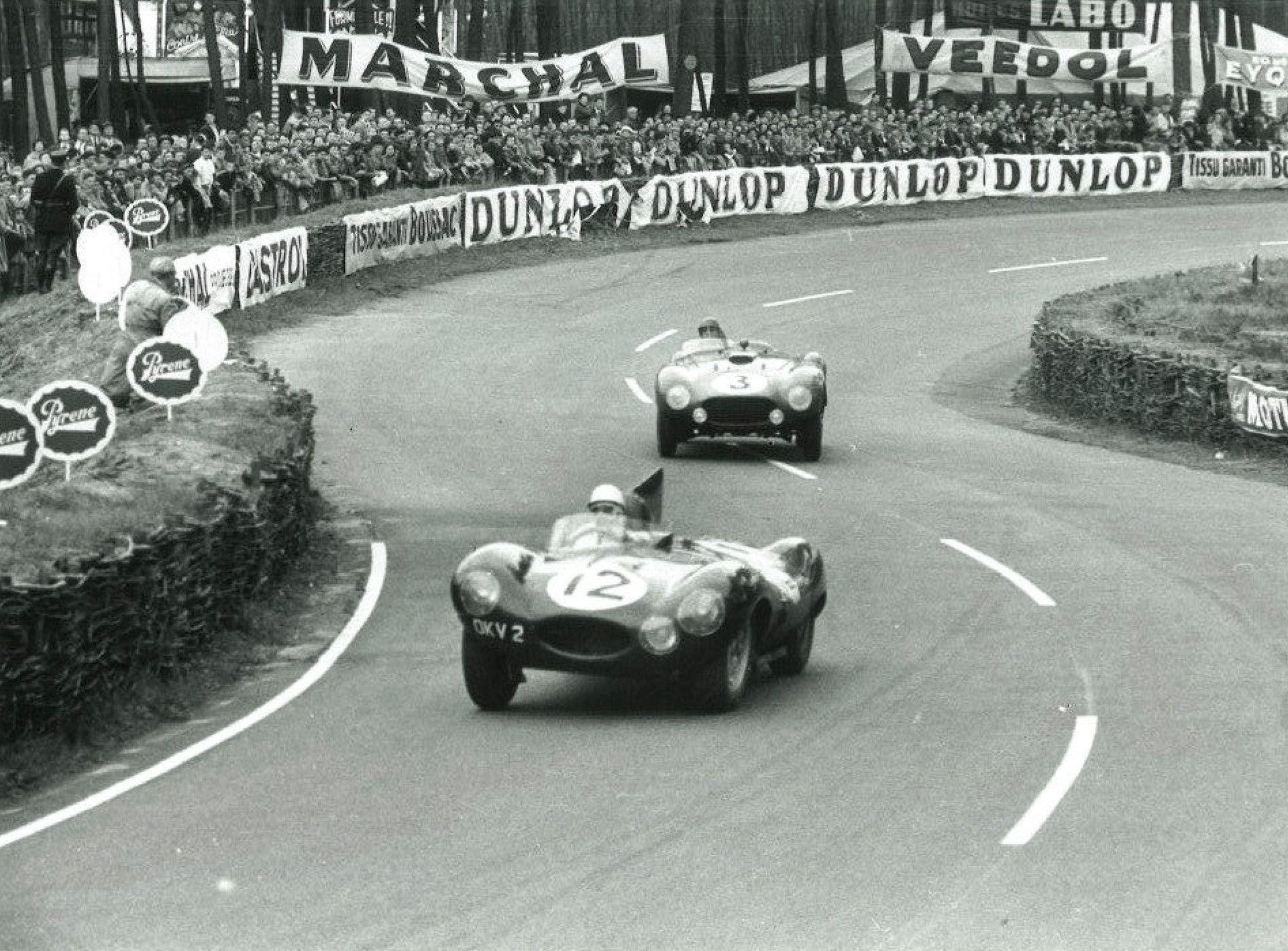
Sometime that spring, OKV 2 was sold to Jack Broadhead for Jaguar’s Public Relations Manager Bob Berry to race. Berry proved himself quite the wheelman that year with numerous fine finishes that included three second place podiums at Goodwood and a further second at Aintree. The team, known as Ecurie Broadhead, went far afield as well, entering the Grande Prémo de Portugal. While en route in France, the team’s transporter broke down. Incredibly, the D-Type was driven nearly 1,000 miles to the event packed with spares, finished 5th, and then completed the return trip back to the stricken truck! Further races that summer at Aintree, Goodwood, and Oulton Park brought good results for Berry. Broadhead entered OKV 2 in the final major race of the season, the RAC Tourist Trophy, once again held at Dundrod where Berry would team up with Ninian Sanderson. Berry was first away off the line, later settling into third place behind Moss in his 300 SL and Hawthorne in his D-Type before dipping a wheel off the course at Quarry Corner, causing a tire to deflate and the D-Type to crest a bank and find itself in a field. Berry himself would note that OKV 2 was rebuilt at Jaguar over the winter with a Works-type integral subframe assembly and fitted with larger diameter roll bars and a 1955-style front bonnet.
Terry Larson notes in his Jaguar D-Type Register that OKV 2 was painted a lighter shade of green for the 1956 season. Bob Berry was once again back at the wheel, though finding time to race became more difficult as his role in the Public Relations Department grew. The Easter Meeting at Goodwood netted OKV 2 and Berry a third place behind Moss in an Aston Martin DB3S and further well-placed finishes again at Oulton Park and Aintree. At that May’s International Daily Express Trophy at Silverstone, Berry guided OKV 2 to first in class and third place overall as start number 7 behind Roy Salvadori and Moss in their DB3Ss. With a full head of steam Broadhead and Berry would enter chassis 403 into the Whitsun Meeting at Goodwood. The June 1956 issue of Motorsport noted that “Berry led from flag-fall driving on the limit” during the over-1,500-cc race finishing first and besting both two Ecurie Ecosse D-Types. The second race for Berry, a Formula Libre event featured both large and small sports cars and even Formula Two cars! The period Motorsport article recounts that “Berry led Flockhart for two sensational laps, then left the road at Fordwater.” Berry and OKV 2 went through the thin fencing, ending up in a field upside down. Berry escaped with a broken ankle and a hospital visit with the shunt necessitating Broadhead’s D-Type be returned to the Jaguar factory for repairs.
XKD 403 – OKV 2
After the car was returned to Coventry to be mended, factory records note that it was “repaired by experimental department after Goodwood shunt.” No doubt Berry’s position within the company moved him ahead in line for repairs, and as a result, the factory utilized the front chassis/subframe from XKD 548 which had been “dismantled for spares” to expedite the work to OKV 2, now stamped XKD 403. The Ecurie Broadhead D-Type OKV 2 would return to action—finished once again in British Racing Green—with Berry at the wheel on the 8th of September placing at the BARC Goodwood Trophy. Two more races for Berry that year at Snetterton and Oulton Park netted good results, yet Sir William Lyons requested Berry make a choice. Would he prefer to be an up-and-coming racing driver or committed Jaguar employee? Bob Berry chose the latter and save for a few races in 1957, his time with OKV 2 had come to an end.
For the 1957 season, OKV 2 would continue to be campaigned by Ecurie Broadhead in a full slate of races. The car was upgraded at Jaguar Works, most notably with a full-width windshield, a passenger door and modified driver’s door. Peter Blond, the Jaguar racer and BRDC member would race the car at the Snetterton Spring Race Meeting on 31 March finishing second in the “unlimited” class 15-lap race. Two races followed at Oulton Park that spring with Ron Flockhart racing the car in the British Empire Trophy races on 6 April and then Berry reunited with the car for a number of club race heats at Oulton Park on 25 May. Formula One racer Jack Fairman brought home a 4th at the Goodwood Whitsun Trophy that June and a fifth at the British GP at Aintree in July. 1957 Le Mans-winner in a D-Type, Ivor Bueb, piloted the car at Sportscar Grand Prix of Belgium at Spa-Francorchamps and then later at Silverstone that September. To finish the year, Bob Berry emerged victorious at Oulton Park, noted to be one of his favorite circuits, that October. Larson notes that in early 1958 the engine was changed and a new gearbox fitted by the factory to prepare it for 1958—a remarkable fifth year in front line international motorsport for OKV 2.
Le Mans champion and D-Type specialist Ivor Bueb was back at the wheel of OKV 2 for the 1958 BRDC International Trophy at Silverstone on 3 May before a new face, Reginald “Reg” Harris, climbed into the driver’s seat. Less known to motorsport fans, Harris was a four-time World Champion cyclist and 1948 Olympic silver medal winner who, like many of his generation, had a taste for speed. It turns out that Harris had a knack for racing cars as well, finishing second and fourth in two races at Silverstone the next weekend followed by race outings at Crystal Palace and at Oulton Park. The year 1959 marked the first time in five years that OKV 2’s engine was quiet for a race season—perhaps a well-deserved rest after five years of international racing, piloted as a works entry at Le Mans by Stirling Moss, raced by Le Mans winners, and even a Olympic medalist always under the OKV 2 registration.
In 1960, the car was sold to Gerald Montgomery “Gerry” Crozier, a Bentley racer, who is noted to have entered the car in at least one hillclimb that year. Crozier likely realized the Le Mans thoroughbred was not an ideal hillclimb car as it was listed in The Chequered Flag the next year, selling to Canadian David Jaycox the future President of Pacific Western Airlines. Apparently Jaycox’s son enjoyed the car more than he should have, with the car listed in short order in the April 1962 issue of Road & Track selling to George F. Gordon. That May the car was represented by Pett & Thompson Motors Ltd. in Toronto with it landing with Jim Catto in 1963. A letter from a potential buyer of the car at the time, Cameron Smith, recounts that British expat Alistair Cameron-Smith had been hired to prep and race the car at the Player’s 200 at Mosport Park that May. Unfortunately for Cameron-Smith, he was involved in a low-speed shunt during Friday practice with the car rolling on its side. During his attempt to extricate himself from the car it further rolled putting him in the hospital, eventually succumbing to his injuries the next day. Catto, perhaps in a state of shock and mourning for his mechanic and driver, stored the car without repairs for the next 15 years.
In the late 1970s OKV 2 was shipped back to England sold to Guy A. Black of Lynx Engineering for restoration. Chris Keith-Lucas, former Director at Lynx, recounts the story: “It arrived as an amazingly un-spoilt ‘time warp’ car.” The engine had been removed and included in a crate and that “the car was otherwise complete and rolling.” Keith-Lucas noted the right-side fenders were crumpled in but that “the headrest was virtually OK” and that “it was not ‘rolled’ in the conventional sense.” He deemed the rebuild straightforward and that the body was returned to shape without the addition of new metal. The engine and gearbox received overhauls and Keith-Lucas recounts that the car was later acquired by Jim Wallis. Wallis raced the car for the first time in decades returning OKV 2 to Silverstone and also piloting it at Brands Hatch. Terry Larson’s Register further states that Robert Cooper of Gloucestershire acquired the car in 1995, using it during Jaguar factory cavalcades to Le Mans in 1995 and 1997. In 1999, Larson himself, a foremost D-Type expert, acquired the car, racing OKV 2 at the Goodwood Revival—just the second running of the glamorous event now entering its 27th year. Larson proved to be as studious a caretaker as any, compiling information from factory sources and former owners. Yet he also found time to pilot OKV 2 in the Colorado Grand, California Mille, Copperstate 1000, and numerous Jaguar C- & D-Type Tours. Under Larson’s stewardship none other than Jaguar Test Driver Norman Dewis piloted the car at the two Monterey Historic Races at Laguna Seca, a momentous reunion of man and machine after 45 years apart.
OKV 2 Today
After 10 years with OKV 2, Larson parted with the car trading it for a Jaguar XKSS. Since that time, the D-Type has been held by a noted west coast collector of significant sports and sports racing cars. Shortly after acquisition in 2010, the D-Type was sent to Intrepid Motorcar Co. of Sparks, Nevada for a thorough inspection and sorting in advance of numerous Monterey Historic races, events at Sonoma Raceway, and even a return to Le Mans in 2012 as part of the Le Mans Classic that July. In 2011, the day after the Pebble Beach Concours d’Elegance, OKV 2 was invited to The Pacific-Union Club in San Francisco to be reunited with Stirling Moss. Those in attendance saw Sir Stirling’s jaw drop at the sight of his 1954 Works Le Mans D-Type with Moss later climbing in the car once again for the first time since Reims nearly 60 years earlier. Further invoices from Intrepid that carry into 2013 cover a full engine rebuild including its cylinder head and regular sorting—the type of work necessary to keep a first-class historic racer at the top of its game in premier events. A 2020 invoice from Intrepid hints at more sedate life for the D-Type in recent years with the installation of street tires and a headlight wiring repair, both necessary changes to enjoy the car on the road.
Today, as it sits, the 1954 Jaguar Works Competition D-Type, forever known as OKV 2, straddles the line between race and road car perhaps better than any other. It was created as the exemplar D-Type, the team lead among its Works brothers—the most advanced endurance sports racing cars of their era. It was piloted by the best of the best including Stirling Moss, Mike Hawthorne, Peter Walker, Tony Rolt, Peter Whitehead, Ivor Bueb, Norman Dewis, Bob Berry, and Reg Harris with Formula One race winners, Le Mans winners, Jaguar employees, and Olympic medalists among them. Furthermore, it is extensively documented by previous owners with period testing and race paperwork with hundreds of spectacular archival racing imagery, and correspondence tracing the history of the car from its construction to the present day. OKV 2 remains a versatile and powerful road/race car and a virtual ticket to any of the core motorsport and touring events that define the year for so many. Perhaps more than that, OKV 2 is at the root of all that is Jaguar, a competition car born to win at Le Mans, raced by legends, that benefitted the engineering and performance of the company beloved by so many for decades to come.
find more news here.
